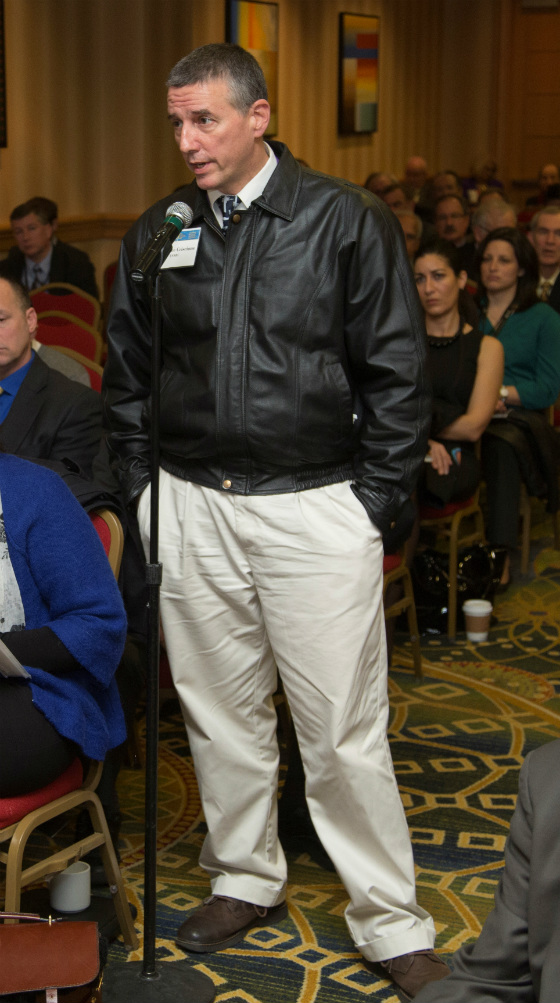To many, the acronym NRC stands for Nuclear Regulatory Commission. At times, NRC has been said to stand for Nobody Really Cares, Nuclear Rubberstamp Committee, and Nielsen Ratings Commission.
In regard to Larry Criscione, it may stand for Nuclear Regulatory Crusader.

(Source: NRC)
Larry is an engineer working for the U.S. Nuclear Regulatory Commission (NRC). Last year, Larry received the Joe A. Callaway Award for Civic Courage from The Safeek Nader Trust. Joe Callaway established the award in 1990 to recognize individuals who, with integrity and at some personal risk, take a public stance to advance truth and justice.
In March 2011, the three operating reactors at the Fukushima Daiichi nuclear plant in Japan melted down after a tsunami generated by a large earthquake flooded the site and disabled primary and backup power supplies to emergency equipment. In public, the NRC denied that reactors operating in the U.S. were vulnerable to such hazards.
In private, the NRC knew otherwise.
Flooding Risk at Oconee
In June 2010—nine months before Fukushima—the NRC issued a Confirmatory Action Letter to the owner of the Oconee nuclear plant in South Carolina requiring more than a dozen measures be taken. The measures were intended to lessen the chances that the Jocassee Dam fails and to increase the chances that the three operating reactors at Oconee survive should the dam fail anyway.
An evaluation showed that if the dam—located about 21 miles upriver from Oconee—failed, the site would be inundated with about 12.5 to 16.8 feet of flood water. The site was protected by a flood wall about seven feet tall, so it mattered little whether the actual depth was 12.5, 13, 14, 15, or 16.8 feet.
The NRC estimated that if the dam failed and flooded the site, there was a 100 percent chance that all three reactors would meltdown.
But the NRC issued the Confirmatory Action Letter secretly and did not tell the public about the hazard it required Oconee’s owner to lessen. After Fukushima tragically demonstrated the hazard posed by flooding, the NRC continued to cover-up measures taken and planned to lessen the flooding vulnerability at Oconee.
Larry and the OIG
So, Larry sent a 19-page letter dated September 18, 2002, to the NRC Chairman chronicling this history and asking four things:
- The NRC’s Office of General Counsel (OGC) should review the documents related to flooding at Oconee and the associated federal regulations to determine whether the documents could be made publicly available.
- The NRC’s Office of Nuclear Security and Incident Response (NSIR) should review the information on flooding hazards redacted from documents released to the public in response to Freedom of Information Act (FOIA) requests to determine whether additional information could be made publicly available.
- Based on the OGC and NSIR reviews, ensure that all flooding hazard documents that can be made publicly available are publicly available.
- The NRC’s Office of the Inspector General (OIG) should investigate whether the agency has been inappropriately marking documents as containing “Security-Related Information.”
Exercising his rights under the Lloyd-La Follette Act of 1912, Larry copied U.S. Congressional staff members on the email transmitting his letter to the NRC Chairman.
Larry’s letter was obtained by a reporter and featured in a Huffington Post article dated October 19, 2012.
As Larry had requested, the NRC’s OIG investigated handling of documents about flooding hazards. But rather than investigate whether NRC had improperly withheld information as he contended, OIG investigated whether Larry had improperly released information. As detailed in our 2015 report on the NRC and nuclear power safety, OIG made Larry an offer—he could voluntarily resign from the NRC or they would turn over his case to the Department of Justice (DOJ) for prosecution.
Larry did not resign.
OIG did refer the case to DOJ.
DOJ did not prosecute.
Through FOIA, UCS obtained DOJ’s response to NRC declining to prosecute Criscione. Under the Primary Reasons for Declination section, DOJ checked one box—No Federal Offense Committed.
Fortunately for Larry, not breaking the law is not yet against the law.
Thanks to Larry’s selfless efforts, the flooding hazards at Oconee have been made public. Larry had been right about the NRC inappropriately withholding information from the public. When lawyers and investigators were all through, the information he sought to have publicly released was publicly released. The NRC lacked legal grounds to continue hiding it.
More importantly, NRC’s mangers may think twice—or at least once—before withholding dam safety information in the future.
Unfortunately for Larry, he experienced unnecessary stress and expense defending himself against baseless OIG investigations. The Callaway Award does not fully offset those unfortunate consequences. But it helps show Larry and others who have our backs that not everyone wants to twist a dagger in their backs.
A video of the award presentation and Larry’s acceptance speech has been posted to YouTube.
Bottom Line
Doing the right thing when it’s relatively easy fails to accurately measure courage.
Larry Criscione did the right thing when it was a very hard thing to do. He could have remained silent like so many of his co-workers opted to do. He faced a strenuous courage test and aced it.
